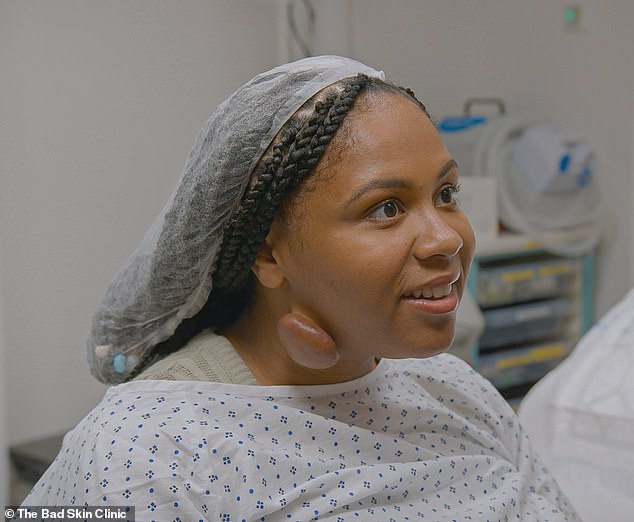A woman underwent life-changing surgery to remove a huge golf ball-sized growth from her neck that had been growing for more than four years.
Olivia, 28, from Dudley in the West Midlands, revealed it has been “exhausting” trying to hide the unusually large keloid, which is a raised scar that has become larger than the original wound and was protruding from the side of her neck.
Desperate to have the growth removed to improve her self-confidence, specialist nurse Olivia said it also began to affect her daily life and her daily work supporting patients with learning disabilities.
In the latest series of The Bad Skin Clinic, Olivia finally reached the point where she had to take action and decided to visit consultant dermatologist Dr Emma Craythorne at her London clinic to have her keloid removed.
She said: “It can be exhausting trying to constantly be brave and trying to hide it.” It’s my face, this is what everyone sees! Many times at the end of the day tears can come, it makes you sad.
Olivia, 28, from Dudley in the West Midlands, underwent life-changing surgery to remove a huge golf ball-sized growth from her neck that had been growing for more than four years.
‘My keloid… really gets in the way. My seat belt often rubs. If I try to wear masks or PPE at work, I feel quite uncomfortable. I’m always rubbing it. It’s like an itch and I can’t stop doing it.’
At an initial consultation at the clinic, Dr Emma confirmed to Olivia that the growth was indeed a keloid and explained how it develops.
Dr Emma pointed out that the growth could have been caused by something as inconspicuous as a small acne spot on her neck.
She said: ‘Basically, the cells we have responsible for creating a scar are called fibroblasts. If you get a cut or have an injury, they start repairing that wound and then once the injury heals, it stops repairing.
‘But in someone who is prone to keloids, those fibroblasts don’t stop producing scar tissue. So, in your case, it is a genetically inherited tendency.
‘I suspect you might even have had a spot, like an acne spot or something. Something really small, and that has been enough to provoke this response.’
However, Dr. Emma had good news for Olivia, as it was likely that the keloid could be easily removed by surgery on the same day.
‘I know you don’t want it there, but it has grown so beautifully and doesn’t seem to penetrate deeply into the nearby skin. “This is a really pretty keloid that should do well with surgery,” said Dr. Emma.
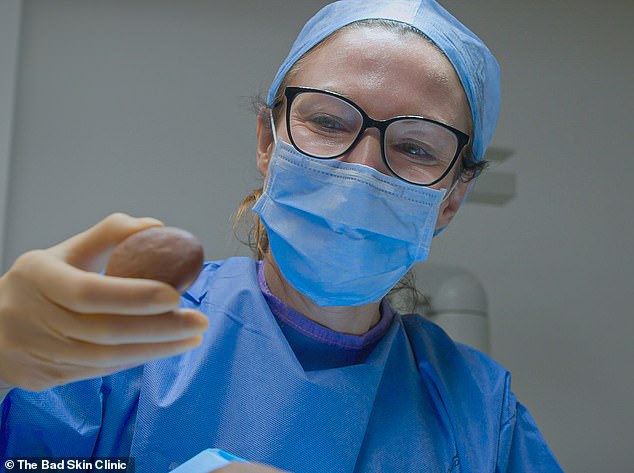
Dr. Emma lifted the keloid after surgically removing it from Oliva’s neck.
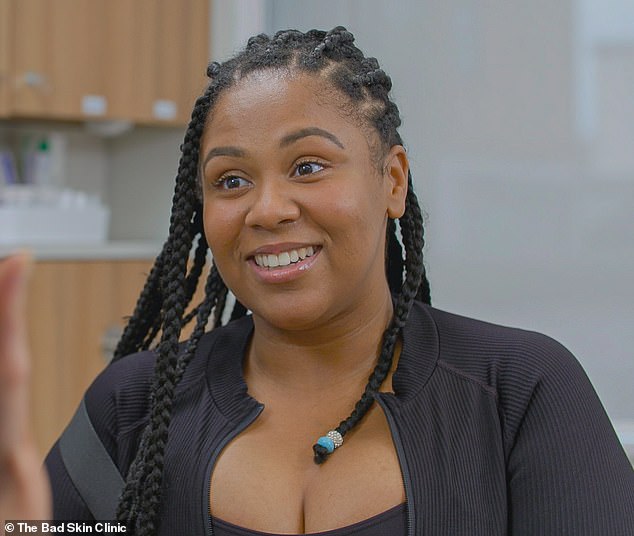
It was clear what a significant impact Olivia’s surgery had had on her self-confidence and positive outlook on life.
Not expecting to have surgery that day, it was clear that Olivia was experiencing mixed emotions, happy to have her keloid removed, but anxious at the thought of surgery.
“I’m shit myself,” Olivia responded bluntly when Dr. Emma arrived in the operating room and asked if she was okay.
After injecting the keloid to numb it, Dr. Emma went to work with her scalpel, slowly and precisely making incisions into the keloid. Fortunately for Olivia, the keloid was not too deep in the skin.
“It’s a fairly superficial keloid… We don’t have to dig deep into the skin to find all its roots,” Dr. Emma said as she precisely and efficiently maneuvered around the keloid from different angles.
“This is where my yoga and Pilates come in,” Dr. Emma joked. Before long, Dr. Emma cut out and completely removed the keloid from Olivia’s neck, completing a successful surgery.
She said, ‘There we go, our friend is gone. It is always very satisfying to get rid of a big lump.”
The doctor then stitched Olivia’s skin in a certain way to reduce further scarring and she quickly grabbed a mirror to show Olivia her new neck.
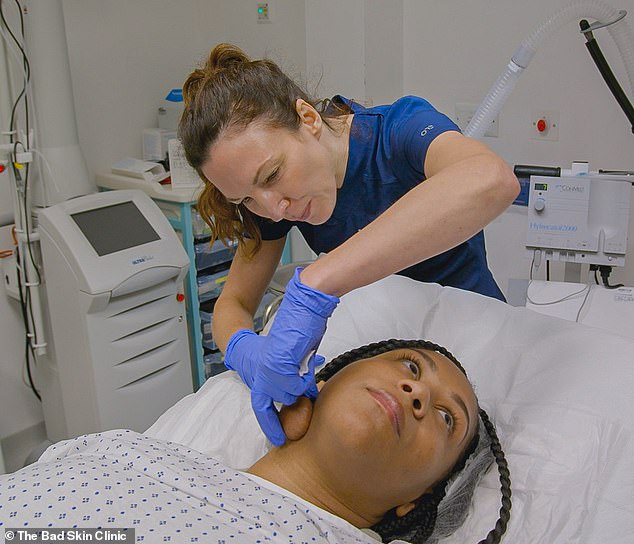
After injecting the keloid to numb it, Dr. Emma went to work with her scalpel, slowly and precisely making incisions into the keloid.
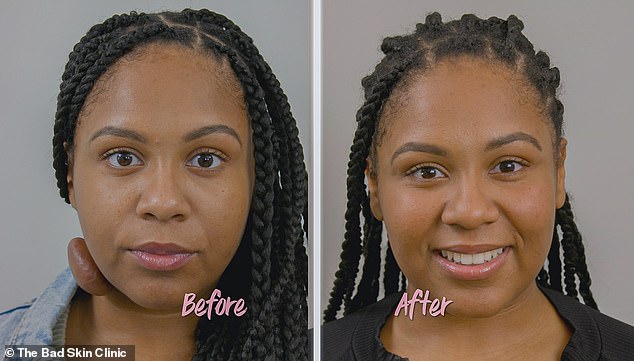
Two weeks after surgery, a delighted Olivia returned to the central London clinic with a spring in her step, excited to show Dr Emma her healing progress and feeling much more confident.
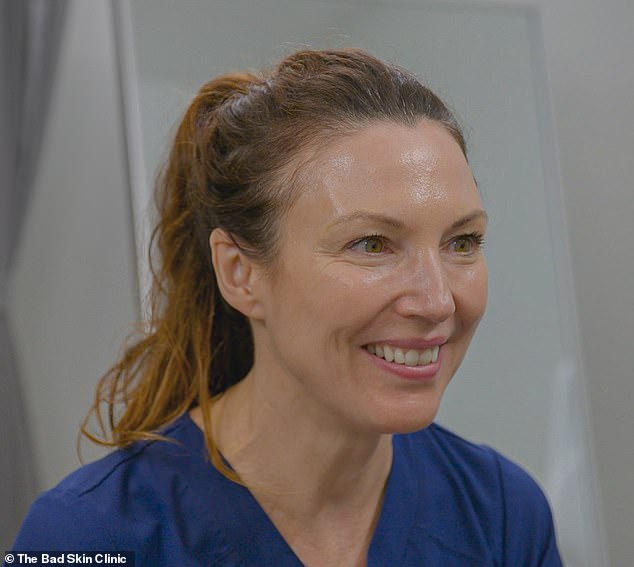
In the new series of The Bad Skin Clinic, Dr Emma and her team face some of the most challenging cases of their career to date, while helping those who have nowhere to turn.
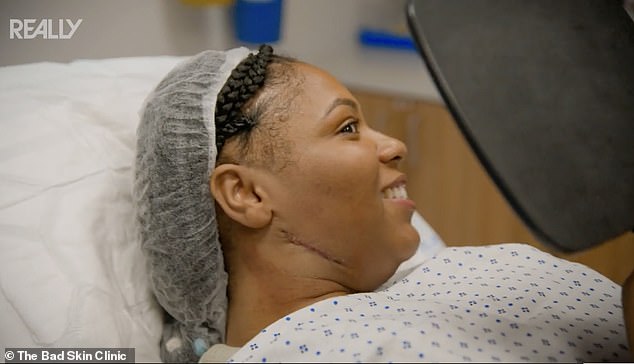
The doctor then stitched Olivia’s skin in a certain way to reduce further scarring and she quickly grabbed a mirror to show Olivia her new neck.
‘When someone has something different on their face, it has an effect on them. You know, our face is very important to us in terms of communication, in terms of breathing, in terms of speaking, in terms of touch, all these things.
“But it’s also crucial that it’s a touchpoint that people look at, so it’s not the same as having a lump growing somewhere else.” “When it’s right in the middle of the face, it impacts all of those senses,” Dr. Emma said.
Two weeks after surgery, a delighted Olivia returned to the central London clinic with a spring in her step, excited to show Dr Emma her healing progress and feeling much more confident.
“I’m looking forward to showing Dr Emma what my face is like. My colleagues have mentioned how good things look, even someone in the chip shop said to me: ‘Oh, it’s gone!’ So I’m looking forward to it.” show him my new face,” Olivia said.
As Dr. Emma checked his neck, she said, ‘Wow. It’s just amazing. Looking at you and you don’t have your wobbly thing here.
‘I know, my little dad,’ Olivia laughed. “Honestly, I feel like people are actually looking at me and talking to me instead of staring at my neck,” she continued.
Dr. Emma noted that the scar is barely visible from certain angles, but she is also curious about the practical benefits of keloid removal.
‘Oh yes! My drawstring doesn’t get stuck, it just slides over…seat belts…even as a bag, I can use it on this side. I could never use a bag this way before. All this kind of stuff, I’m so happy,’ Olivia replied.
It was clear what a significant impact Olivia’s surgery had had on her self-confidence and positive outlook on life.
‘I feel so pretty… having it removed literally changes my life. I’m much more confident, I’m not conscious when I take pictures or even when I walk.
‘I’m not really trying to cover my face anymore. I feel so pretty. My life now is amazing. I feel great, very confident, very happy. Just excited about the future.’
In the new series of The Bad Skin Clinic, Dr Emma and her team face some of the most challenging cases of their career to date, while helping those who have nowhere else to turn.
‘When a skin disease affects the face it can be devastating. Not only physically, but also emotionally and socially. And that’s where I come in,” he explained.
The Bad Skin Clinic airs on Really on Tuesdays at 9pm and is available to stream on Discovery+.

